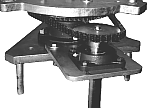|
|
Rotating Tower Systems |
|
|
"THE ORIGINAL AND STILL THE BEST" |
|
|
Rotating Tower Systems |
|
|
"THE ORIGINAL AND STILL THE BEST" |
|
Rohn 45 &
55 |
|
The guy wire attachment hole has a diameter of .75 inch in a .75 inch thick steel anchor plate. The outer ring is 1.00 inch steel as are the vertical uprights which house three of the cam followers. The inner ring is 1.25 inch thick for the Rohn 45 unit and 1.50 inch thick for the Rohn 55 unit. The inner and outer rings are made of steel and are hot dip galvanized after fabrication. The inner ring mounts in line between two tower sections. Solid steel stubs which mate with the upper tower section go through the inner ring and are welded on both sides. The lower tower section is secured to the same stubs. This method of attachment allows for the installation of at least two tower sections above the highest guy wire bearing. This feature provides a very strong mast for mounting antennas, not to mention it can be climbed. Standard tower leg hardware is used to secure the inner ring to the tower sections. Since the outer ring is stationary, it can be the end support for wire antennas, either slopers fed against the tower, inverted vee's or the end support for other types of wire arrays. Guy ring spacing will vary between 30-40 feet for Rohn 45G and 40-50 feet for Rohn 55G. Spacing for both designs will depend on the amount of wind loading on the tower from installed antennas and the tower construction requirements in your wind zone area. (i.e. 70, 80 or 110mph) |
||
|
The standard rotor bracket is set for the Hy-gain HDR-300 rotor. A bracket for the M2 Orion or a Prop-pitch rotor can be supplied in place of the standard bracket. Please specify the type required when ordering a system. With the grounding kit, direct DC and RF paths across the rotating base unit are provided. This provides a static discharge path and allows the tower to be shunt loaded through the rotating base unit. The rotating tower can be shunt loaded for use on the low frequency bands as though it were a stationary tower. |
||
|
Drive Shaft Bearing -- This bearing has a load rating of 4,450 pounds. It's a commercially available unit with seals and is lubricated through a grease fitting. |
 CLICK TO ENLARGE |
|||
|
The choice between 45 and 55 tower is based on the wind conditions expected, the total area and weight of the antennas to be mounted, and the boom lengths. Not only must the tower hold up the antennas, but turn them as well. Many large Yagis are not aerodynamically symmetric and can put very large twisting loads into the tower. For installations with full size 40m beams and large long boom monobanders, 55 tower should be considered. For installations with smaller monobanders and reduced size 40m beams, 45 may be more appropriate. |
||
|
Home |
Price List | Gallery
| Reviews | Customers |